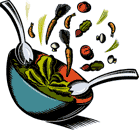

A new study on antioxidants confirms the need to take a holistic approach to hypertension treatment.
By Sarah McAdams

People trying to regulate their high blood pressure have known for a long time that fruits and vegetables can help. But for the first time, they may know exactly why.
Researchers at the University of California at Irvine's College of Medicine recently elucidated the role of antioxidant vitamins E and C, found in fruits and vegetables, in lowering blood pressure.
Using dietary approaches in the treatment of high blood pressure, or hypertension, isn't a revolutionary idea. However, with increasing emphasis on balancing lifestyle factors with blood pressure pills to reduce the amount of medication needed and to curb unwanted side effects, nutrition is a key component in achieving that goal.
Dr. Nostratola Vaziri, Chief of Nephrology at UCI, who headed up the study says "A biological system like fruits and vegetables has been balanced by nature, so they will not upset our balance."
The Biology of Nutrition
Antioxidants, like vitamins E and C, found in fruits and vegetables, increase nitric oxide levels in the body. The molecule nitric oxide is a naturally occurring chemical that regulates blood pressure.
For instance, when a person gets angry, the brain sends signals that can raise blood pressure from normal to dangerously elevated levels in a matter of seconds. Nitric oxide dampens those signals by relaxing blood vessels, thereby regulating blood flow and pressure.
The problem is that free radicals--molecules found in certain diets and in the atmosphere that are able to damage your body through a process called oxidation--reduce nitric oxide content in the blood. In turn, blood pressure spikes.
"If someone steals money from you, you cannot spend it. Similarly, when nitric oxide is inactivated by free radicals, you cannot dilate, so you become constricted," explains Vaziri.
When Vaziri and his team tested the hypothesis on two groups of rats, they found that antioxidant vitamins E and C together helped to reduce blood pressure by almost 50 percent in the rats.
Balancing act
This promising news does not mean the average person with hypertension should start liquefying and injecting bushels of spinach and oranges into his or her system.
"A balance in the antioxidant system is critical–and vitamins E and C are just two of hundreds of antioxidants," Vaziri says. "Too much of something good is not necessarily good. It's like with a four-legged chair-you want all four legs to be proportional, otherwise there will be an imbalance.
Vaziri advises ingesting FDA-recommended amounts of vitamins E and C. The important thing, he says, is not to ignore either in your diet.
The first line of treatment
"Dietary and lifestyle changes are very important for patients with hypertension," says Norma Keller, M.D., an interventional cardiologist and director of the Coronary Care Unit at Bellevue Hospital in New York City.
Keller says that immediately upon being diagnosed with hypertension, patients should be counseled to eat a low salt diet, get moderate exercise, maintain weight and start a medication regimen.
Medication measures
Dr. Johann Georg Schnitzer, a Germany-based M.D. and widely known hypertension researcher, thinks hypertension pills should be tempered with lifestyle changes, as they come with unwanted side effects,
He says that traditional Western blood pressure medication treats the symptom of high blood pressure by forcing it down to a normal level. This process results in narrower blood vessels and thicker blood.
"The consequence is an insufficient supply of oxygen and energy to the body, and this is the cause of the disagreeable 'side effects' many people suffer from, as soon as they start taking hypertension pills," Schnitzer says.
The desire to decrease the side effects -- such as skin rash, sleepiness or weight gain -- or the amount of blood pressure medication needed is one reason people might seek out a an approach to treatment that addresses lifestyle factors such as nutrition, diet, exercise and stress management .
Improving lifestyle factors - like introducing exercise, ceasing smoking, and cutting back on cholesterol - can decrease the amount of medication needed on a daily basis, Keller says.
"But it really depends on the individual," she says. "It is best to individualize the medication, as what is needed is particular to each patient."
No cure-all
Hypertension is a condition that is the result of many possible different pathologies, Vaziri says. Thus, one person's hypertension is different from another's, and so the treatments must be different.
Don Posner, founder of the Los Angeles-based Organic Medicine Laboratories Inc. says, "Treatments vary depending on the causes. If anyone tells you that they have a single cure-all, I'll tell you that they are not really being truthful."
One way people with hypertension can integrate holistic measures into their treatment "is to look at their life and address the problems that exist. Look into your diet, exercise and stress and improve your life. In general, it is best for hypertension patients to curb stress levels and smile inwardly," says Posner.
Copyright © 2000-2025 savvyHEALTH.com. All rights reserved.
http://www.savvyHEALTH.com/
All contents copyright © 1999-2025 savvyHEALTH, Inc. All rights reserved.
This internet site provides information of a general nature and is
designed for educational purposes only. If you have any concerns about
your own health, you should always consult
with a physician or other healthcare professional. Please review the Terms of Use before using this site. Your use of the site indicates your agreement to be bound by the Terms of Use.